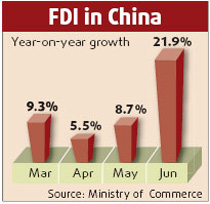By the end of November, cumulative total indirect cross-strait trade had exceeded 700 billion U.S. dollars since the Chinese mainland's opening-up in the late 1970s, marking a new era of deeper and wider economic cooperation across the Taiwan Strait.
Statistics from the mainland show that for January-November 2007, the indirect trade between the mainland and Taiwan reached 113 billion U.S. dollars, up 14.9 percent year-on-year.
"The mainland has become the largest export market and largest contributor to the favorable balance of trade for Taiwan," said Ye Kedong, deputy director of the Taiwan Affairs Office of the State Council.
In the first 11 months of this year, 2,993 Taiwan-funded projects, with an actually utilized investment of 1.43 billion U.S. dollars, were approved by the mainland. By the end of November, the mainland had drawn some 45.33 billion U.S. dollars of cumulative direct investments from Taiwan.
Statistics from the Taiwan authorities show that, from this January to October, Taiwan traders invested a record 7.66 billion U.S. dollars in the mainland, and the full-year figure was expected to reach 10 billion U.S. dollars. This compares with a cumulative amount of almost 70 billion U.S. dollars in the past 20 years, indicating a recent rise in interest from Taiwan.
Recently, the number of applications from Taiwan traders to invest on the mainland doubled, causing a backlog of work among the officials with the local investment approval committee.
Taiwan merchants showed more interest in the comparatively undeveloped central and western areas in 2007. Western provinces and municipalities, including Guangxi, Guizhou and Chongqing, attracted far more investment from Taiwan than before.
The investment trend has changed as markets in the developed eastern coastal areas are becoming saturated while other areas are all showing rapid, sound economic development, said Tang Wei, an official with the Ministry of Commerce in charge of trade affairs between the mainland and Taiwan, Hong Kong and Macao.
"Move westwards" and "expand northwards" are among the most frequently used phrases by Taiwan merchants recently, reported the Taiwan-based China Times in September.
Since 2006, the mainland has adopted policies and measures to limit exports of products made in energy-intensive, high-pollution facilities and to promote the transformation and upgrading of the export processing trade.
Meanwhile, the improved economic environment and the mainland's new policy on trade have helped Taiwan traders to improve the overall investment arrangements and encouraged them to explore new industries, including high technology, new materials and services.
Although the manufacturing industry was still the top activity in the cross-strait economic cooperation, investments in primary and tertiary industries both rose in the first three seasons.
Investment in real estate and farming, fishing and forestry increased by 32.4 percent and 35.2 percent, respectively, while investment in architecture led with a hike of 97 percent.
Services, especially product services and business and commercial services, became a newly preferred type of business among Taiwan merchants, said professor Li Fei of Xiamen University in Fujian Province.
During 2007, the mainland issued policies to promote cross-strait cooperation in various sectors, including transportation (roads, shipping and aviation), farming, television series, arbitration and many others.
The policies were believed to have been significant factors in cross-strait economic cooperation.
(Xinhua News Agency December 30, 2007)


